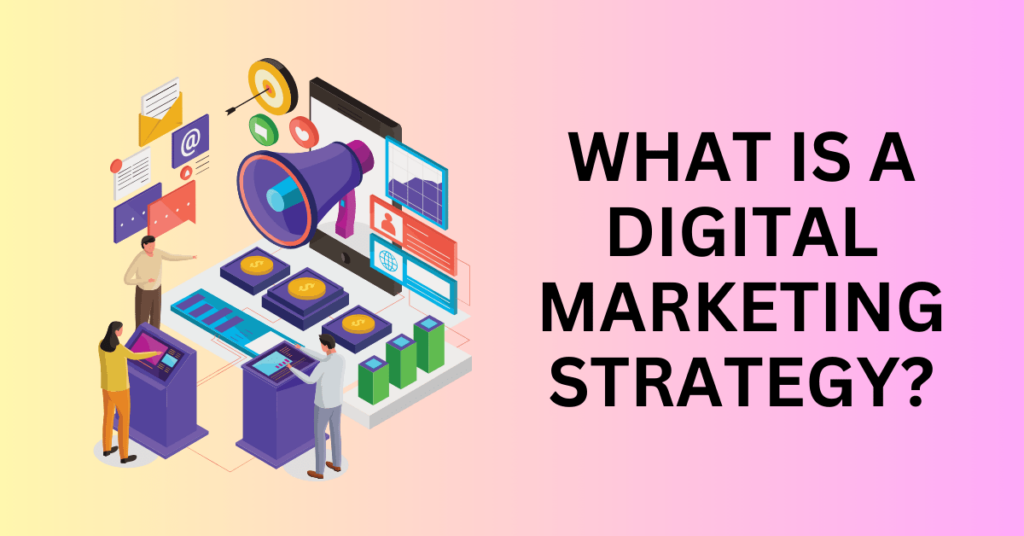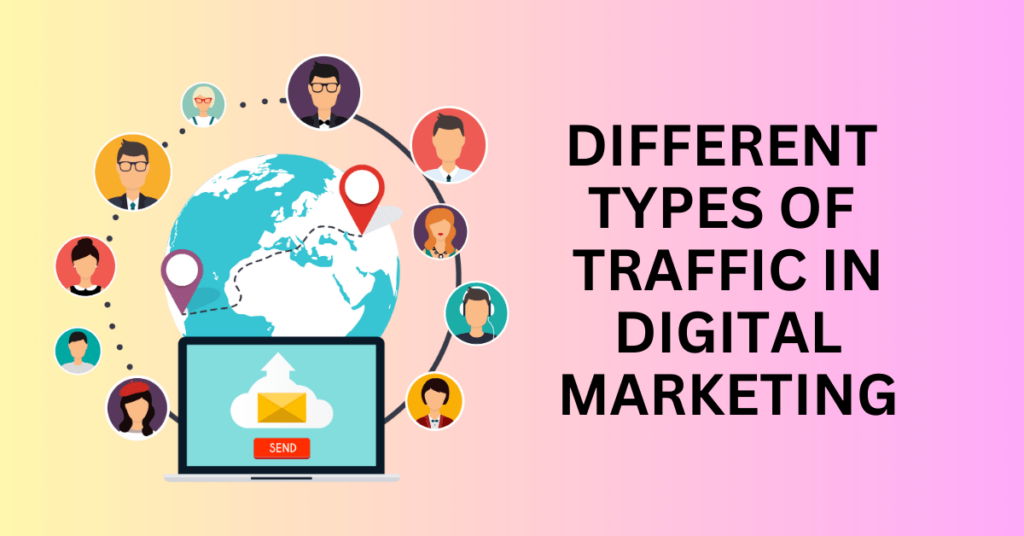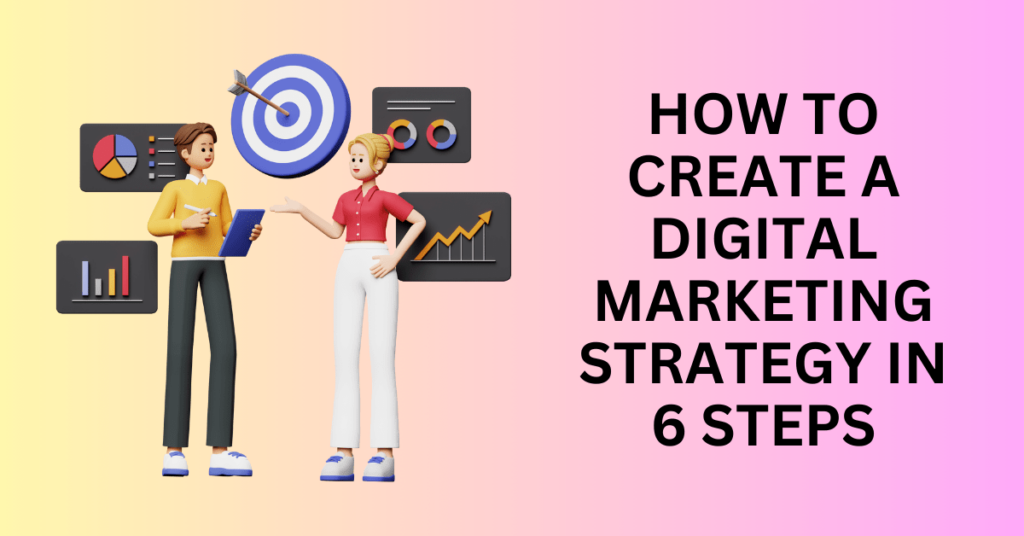When you are running a business, you need to be aware that people will not be excited to buy from you. Hence, you need to have a digital marketing strategy to promote your product so people will be aware of your existence and buy from you. Digital marketing is a way to reach more targeted customers effectively through the Internet.
When you are fighting with both online and offline business, there is no way people will find you if you don’t show yourself. Hence, you will need to raise your hand and show your business to them.
This is to tell them that you are there for them when they need you.
In this guide, we will be sharing what is a digital marketing strategy. Also, how you can create your own strategy to reach more people for your business and products.
What is Digital Marketing?

Digital marketing refers to the practice of promoting products, services, or brands using digital channels and technologies. It leverages the vast and interconnected digital landscape. This includes the internet, social media, email, search engines, websites, mobile apps, and various other online platforms.
In addition, the primary aim is to connect with a targeted audience, engage them, and encourage specific actions. This will also include actions like making a purchase, signing up for a newsletter, or sharing content.
Key components of digital marketing include
- search engine optimization (SEO) to enhance online visibility and rankings in search results
- pay-per-click (PPC) advertising for immediate visibility through paid ads
- content marketing to create valuable and relevant content that attracts and engages the audience
- social media marketing for brand promotion and interaction, email marketing for personalized communication with potential and existing customers, and
- analytics to measure performance and optimize strategies.
Digital marketing enables businesses to reach a global audience, target specific demographics, track consumer behaviour, and adjust marketing efforts in real time. They can then make changes to the marketing strategy based on data insights.
This makes it a crucial tool in today’s modern marketing landscape. Overall, digital marketing empowers businesses to effectively connect with their audience, drive engagement, and achieve their marketing goals.
Claim the free Traffic Secrets Book
What is A Digital Marketing Strategy?

A digital marketing strategy is a comprehensive plan outlining how a business or organization will use digital channels and platforms to achieve its marketing objectives. Furthermore, it involves leveraging online tools and techniques to connect with target audiences, promote products or services, and drive desired actions.
The strategy encompasses various elements. This also includes target audience analysis, market research, goal setting, channel selection, content creation, distribution strategies, budget allocation, and performance measurement.
Firstly, understanding the target audience is important. This involves identifying the specific demographics, behaviours, preferences, and needs of the audience to tailor marketing efforts accordingly.
Then, it’s crucial to choose the appropriate digital channels. This will also include social media, search engines, email marketing, content marketing and paid advertising that aligns with the audience’s online presence and behaviour. Content creation is central to engaging the audience, and it should also be valuable, relevant, and optimized for each chosen channel.
Additionally, setting measurable goals and regularly analyzing performance data allows for the optimization of strategies and the achievement of marketing objectives in a dynamic digital landscape.
A well-crafted digital marketing strategy helps a business effectively reach and engage its target audience, drive traffic, and increase conversions. Ultimately, it will also contribute to its growth and success in the online realm.
Different Types of Traffic in Digital Marketing Strategy

Overall, we can summarize the different types of traffic into three different groups.
Organic Traffic: Organic traffic comes from organic search results like search engines or social media. This is where your content is shown to the right audience and people click on the link to visit your site.
Paid Traffic: Paid traffic is where you are buying the traffic. It can be paid ads like Facebook ads, Google ads, YouTube ads, or TikTok ads. Or it can be paid collaborations and influencer marketing where you are buying the traffic from someone else. Once you stop paying for it, the traffic stops.
Owned Traffic: Owned traffic is the group of people that are either your followers on your Social media, YouTube or any other platforms. It can be also your Facebook group, email list, WhatsApp group or other private network group that you built. You have access to reach these people anytime without requiring them to pay or rely on a third party.
Overall, all these three traffic sources are important for your digital marketing strategy as they will help fill your leads quickly. Eventually, you should convert all your organic traffic and paid traffic audiences to your owned traffic. By owning the traffic, you are not likely to be affected by the hike in ad cost.
Claim the free Traffic Secrets Book
Types of Digital Marketing Tactics

To implement your digital marketing plan, there are different tactics that you can use to bring in more traffic both organically and paid.
Digital marketing tactics you can implement include:
1. Search Engine Optimization (SEO)
Search Engine Optimization (SEO) is a vital digital marketing tactic aimed at optimizing a website to improve its visibility in search engine results, ultimately driving organic (non-paid) traffic.
It involves a combination of on-page and off-page strategies. On-page SEO focuses on optimizing elements within the website, such as content, meta tags, headings, and site structure, to make it more appealing to search engine algorithms. Off-page SEO involves building quality backlinks from reputable sources to boost the website’s authority and credibility.
The ultimate goal of SEO is to rank higher in search engine results pages (SERPs) for specific keywords related to a business or its products/services. This increased visibility will also translate to more organic traffic and potentially more conversions.
SEO is a dynamic field that continually evolves with updates in search engine algorithms. Successful SEO strategies require thorough keyword research, content optimization, technical improvements, and regular performance monitoring to stay ahead of the competition and achieve sustainable online growth.
2. Content Marketing
Content marketing is a strategic approach that involves creating and distributing valuable, relevant, and consistent content to attract and engage a target audience. This content can take various forms, including blog posts, articles, videos, infographics, podcasts, and more.
The primary aim of content marketing is to provide value to the audience, address their pain points, and establish the brand as an authority in the industry.
High-quality, informative content not only drives organic traffic but also nurtures leads and fosters customer loyalty. It’s essential to understand the target audience’s preferences and behaviours to tailor the content accordingly.
Content marketing is a long-term strategy that focuses on building relationships with consumers by delivering valuable insights, which can lead to increased brand awareness, customer retention, and ultimately, conversions.
SEO enhances a website’s visibility in search engine results through various strategies, while content marketing revolves around creating and distributing valuable content to engage and educate the target audience.
3. Email Marketing
Email marketing involves sending targeted messages to a group of people through email to promote products, and services, or engage and nurture customer relationships. It’s a highly effective digital marketing tactic due to its ability to reach a specific audience directly.
Email marketing encompasses various strategies, such as personalized email campaigns, newsletters, transactional emails, and automated sequences.
One of the significant advantages of email marketing is its potential for segmentation and personalization. Marketers can tailor content based on recipient behaviour, preferences, or demographics, resulting in higher engagement and conversions.
Additionally, it allows for tracking and analyzing performance metrics, enabling marketers to refine their strategies for better outcomes. When executed effectively, email marketing can drive traffic, nurture leads, encourage repeat purchases, and strengthen brand loyalty.
4. Affiliate Marketing
Affiliate marketing is a performance-based digital marketing tactic. This is where businesses collaborate with affiliates (individuals or other businesses) to promote their products or services. Affiliates earn a commission for each sale, click, or lead generated through their marketing efforts.
This strategy creates a win-win situation. The business gains increased exposure and sales, while affiliates earn income without the need for the products.
Affiliate marketing operates through affiliate links and unique identifiers assigned to affiliates. This allows the business to track and attribute conversions accurately. Successful affiliate marketing campaigns require identifying suitable affiliates, providing them with the necessary marketing materials and support, and fostering a mutually beneficial partnership.
It’s essential for both parties to align on goals and expectations to ensure a productive and profitable affiliate marketing program.
Email marketing involves targeted messaging via email to engage and nurture customer relationships. However, affiliate marketing is a performance-based strategy involving partnerships to promote products or services and earn commissions.
Next, we’ll explore influencer marketing and social media marketing.
5. Influencer Marketing
Influencer marketing leverages the influence of individuals or groups (influencers) who have a significant following and impact on a particular audience. These influencers, often found on social media platforms, collaborate with brands to promote products or services to their followers.
The goal is to tap into the trust and rapport the influencer has with their audience to drive brand awareness, credibility, and ultimately, sales.
Choosing the right influencers who align with a brand’s values and target audience is crucial for a successful influencer marketing campaign. The content created by influencers should resonate with their followers and authentically showcase the brand, encouraging engagement and fostering a positive brand image.
Additionally, measuring the ROI of influencer marketing efforts is essential to evaluate the campaign’s effectiveness and optimize future collaborations.
6. Social Media Marketing
Social Media Marketing involves leveraging social media platforms to promote a brand, product, or service and engage with the target audience. It encompasses various activities, including creating and sharing content, running paid advertising campaigns, engaging with followers, and analyzing performance metrics.
The primary platforms for social media marketing include Facebook, Instagram, Twitter, LinkedIn, and others, each offering unique advantages and audience demographics.
Successful social media marketing strategies involve understanding the target audience, tailoring content to suit each platform, and maintaining a consistent brand voice and message. Engaging content, timely responses to comments and messages, and utilizing paid advertising to reach a broader audience are key components of an effective social media marketing plan.
Additionally, analyzing social media metrics like reach, engagement, and conversions helps optimize strategies and achieve the desired marketing objectives.
Influencer marketing utilizes influential individuals or groups to promote products or services, leveraging their reach and credibility, while social media marketing involves using social platforms to engage with the audience and promote a brand or offerings.
Lastly, let’s discuss search engine marketing.
7. Search Engine Marketing (SEM)
Search Engine Marketing (SEM) is a comprehensive digital marketing approach that involves promoting a website or landing page by increasing its visibility in search engine results through both paid advertising and organic strategies.
SEM primarily encompasses Pay-Per-Click (PPC) advertising, where advertisers bid on specific keywords relevant to their business to display ads in search engine results.
PPC ads appear above or below organic search results and charge the advertiser a fee each time a user clicks on their ad. These ads are highly targeted, allowing advertisers to reach their intended audience based on keywords, location, and other demographic factors.
Advertisers can control their budget and measure the performance of their campaigns through metrics such as click-through rate (CTR), conversion rate, and return on investment (ROI).
In addition to paid advertising, SEM includes organic search strategies like SEO to improve a website’s visibility and rankings in the non-paid (organic) search results. A well-rounded SEM strategy integrates both paid and organic tactics to maximize online visibility, drive traffic, and achieve marketing goals effectively.
SEM encompasses paid advertising through PPC and organic strategies like SEO to increase a website’s visibility in search engine results, combining both approaches for a comprehensive digital marketing strategy.
Claim the free Traffic Secrets Book
How to Create A Digital Marketing Strategy in 6 Steps

Since there are so many different tactics that we explained, a strategy is required to implement the right digital marketing strategy for your business.
In this section, we will be sharing how to create a digital marketing strategy
1. Define and Understand Your Target Audience
Defining and understanding your target audience is the foundational step in creating an effective digital marketing strategy. After all, your target audience comprises the individuals or groups you want to reach and engage with your products or services.
To define this audience, conduct market research to gather demographic, psychographic, and behavioural data. Demographic factors may include age, gender, location, and occupation. Psychographic factors encompass lifestyle, values, interests, and attitudes. In addition, behavioural data involves understanding their buying behaviour, online preferences, and past interactions with your brand.
Once you have a clear understanding of your target audience, create detailed buyer personas. These are semi-fictional representations of your ideal customers, including their needs, challenges, goals, and how your product or service can solve their problems.
Understanding your audience deeply helps tailor your marketing efforts, messages, and channels to effectively reach and resonate with them.
2. Set Your Marketing Goals
Setting clear and achievable marketing goals is the second crucial step. These goals should align with your overall business objectives and be specific, measurable, achievable, relevant, and time-bound (SMART).
For example, marketing goals might include increasing website traffic, generating leads, boosting sales, improving brand awareness, or enhancing customer engagement. Each goal should have key performance indicators (KPIs) associated with it, allowing you to measure your progress and success.
For instance, if your goal is to increase website traffic, you could measure it by the number of unique visitors, page views, or time spent on the site. Align these goals with the stages of your customer’s journey, such as awareness, consideration, and conversion, to ensure a cohesive and effective marketing approach.
These goals will serve as a roadmap for your marketing strategy, guiding your decisions and tactics throughout the process.
3. Establish Your Budget and Tech Stack
Determining your budget and selecting the right technology stack are critical components of your digital marketing strategy. Your budget should also consider all aspects of digital marketing, including advertising costs, software subscriptions, content creation, and personnel.
Allocate funds based on your goals and the channels you plan to utilize. It’s essential to track and manage your spending to ensure you stay within budget and achieve a positive return on investment (ROI).
Simultaneously, your tech stack comprises the tools and technologies needed to execute your marketing strategy efficiently. This can include customer relationship management (CRM) systems, email marketing platforms, social media management tools, analytics software, and more.
Finally, choose tools that align with your goals and enable automation, data analysis, and campaign management. A well-structured tech stack streamlines your marketing efforts and empowers you to make data-driven decisions.
4. Select the Marketing Tactics to Attract, Nurture, and Convert Customers
Choosing the right marketing tactics is a pivotal step in achieving your marketing goals. These tactics should align with your target audience, goals, and budget.
First, consider a mix of inbound and outbound marketing strategies. Inbound tactics attract and engage your audience organically, such as content marketing, SEO, and social media.
Outbound tactics involve reaching out to potential customers directly, like email marketing, pay-per-click (PPC) advertising, and influencer partnerships.
Then, tailor your tactics to the different stages of the customer journey. For attracting customers, focus on creating engaging content and optimizing your website for search.
For nurturing, implement email campaigns and personalized experiences. To convert customers, employ persuasive calls-to-action, landing pages, and optimized checkout processes.
Finally, you should analyse the performance of these tactics regularly and adjust your strategy to optimize results.
5. Focus on Your Differentiators
Identifying and emphasizing your unique value propositions is key to standing out in a competitive digital landscape. Determine what sets your brand apart from competitors and use these differentiators as the foundation of your marketing strategy.
Whether it’s exceptional customer service, innovative products, or a compelling brand story, highlight these aspects in all your marketing communications.
Craft compelling and consistent messaging that conveys your differentiators across various channels. Showcase customer testimonials, case studies, or user-generated content to substantiate your claims.
By focusing on your unique strengths, you’ll resonate with your target audience and create a lasting brand image that drives loyalty and advocacy.
6. Define a Way to Track Results
To ensure the success of your digital marketing strategy, establish a robust system for tracking and analyzing results. This involves regularly monitoring the performance of your campaigns against the predetermined KPIs.
Use analytics tools to measure website traffic, conversion rates, email open rates, click-through rates, social media engagement, and more.
Analyze this data to identify trends, strengths, weaknesses, and areas for improvement. Adjust your tactics and strategies based on these insights to optimize future campaigns continually.
Regular reporting and reviewing the results of your marketing efforts provide valuable insights to refine your approach. You can then allocate resources effectively, and achieve the best possible ROI.
Creating a successful digital marketing strategy involves understanding your target audience. You need to set clear goals, manage your budget and tech stack, select appropriate marketing tactics, emphasise your differentiators, and establish a robust system to track and analyze results.
A well-crafted strategy that’s flexible and data-driven will help you achieve your marketing objectives and drive sustainable business growth.
Claim the free Traffic Secrets Book
Final Thoughts – What Is a Digital Marketing Strategy?
Digital marketing is very powerful in reaching a huge group of targeted audiences that are interested in your products. It gives the advantage of analyzing the results of the marketing implemented.
With the right digital marketing strategy implemented, you can scale your business fast.





